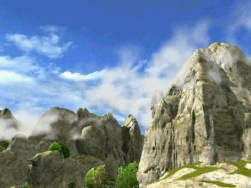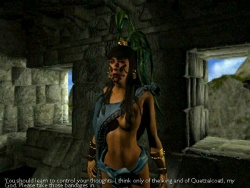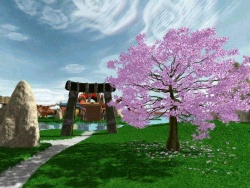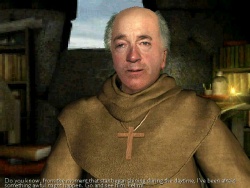|
Atlantis II / Beyond Atlantis (Second Opinion)
 Yup,
that should be the title of this little number. Sorry, but I'm growing very tired of games that
present themselves beautifully, have decent backstories with well-developed characters (that you
can actually talk to!), but fall flat on their faces when it comes to gameplay. So it is with
Atlantis II, the latest offering from Cryo Interactive. Mind you, though I didn't get a
chance to play it, the first game in the series, Atlantis:
The Lost Tales seems to have suffered from the same type of gameplay problems, going by the
review from my former colleague, Diana [alas, this review no longer available - ed.]. Yup,
that should be the title of this little number. Sorry, but I'm growing very tired of games that
present themselves beautifully, have decent backstories with well-developed characters (that you
can actually talk to!), but fall flat on their faces when it comes to gameplay. So it is with
Atlantis II, the latest offering from Cryo Interactive. Mind you, though I didn't get a
chance to play it, the first game in the series, Atlantis:
The Lost Tales seems to have suffered from the same type of gameplay problems, going by the
review from my former colleague, Diana [alas, this review no longer available - ed.].
In this sequel, you take on the role of Ten, a descendent of Seth, the hero of the previous game.
You begin your quest to save the world (of course) by trekking up a mountain somewhere in Tibet.
There, you encounter your mystical mentor, who... sort of explains what you are meant to do. Hey,
don't ask! It's a male bonding thing, like the Old Sage/Grasshopper relationship from the 70's
Kung Fu TV series. What basically happens next is that you get whisked off to one of 3 locales,
depending on which order you place the 3 magical stones you've been given into a strange device. In
each place, your 'astral' form takes over the body of the first citizen you encounter upon arrival.
The 3 locales are:
- The Yucatan - here you take over the body of a young warrior in a majestic mountaintop village.
The corn crop is failing, the village is in danger of attack by a hostile army, and the king is making
blood sacrifices (his own) to the gods in a desperate attempt to ward off impending disaster. If you
cannot get 'chulel' (er... magical assistance) from the gods before the next dawn, the king has vowed
to take his own life and his young daughter's in order to appease his god, who is... sleeping. It is
your task to journey to the Land of the Dead, awaken this god, and secure his chulel.
- China - where you take on the role of a young magistrate who stumbles upon a monastery where the
monks are trapped inside due to a huge, menacing shadow that is blocking the exit. It would seem that
all the exorcists that could tackle the job are out roaming the countryside, so it's you who is left
to save the day. Here, you must travel into another plane of existence, and convince a man who has been
missing, presumed dead for 300 years to give you a means to vanquish the shadow.
- Ireland - and if you thought those sounded tough... in Ireland you play as Brother Felim, who must
find the missing hand(!) and sword of a king who lives inside a book(!!), so that the king may vanquish
an evil ogre who is spoiling all his fun. To complicate matters, the goddess Aine has turned the only
person who can really help you into a wooden statue...
 Anyway,
this being an adventure game, what you've ultimately got to do is solve some puzzles, but we'll
come to that later. First, a few words about the aesthetic aspects of the game. As can be seen from the
above shot from the Yucatan section, the scenery is magnificent, rendered using Cryo's now ubiquitous
Omni Sync engine. It features the familiar 360 degree panning and 180 degree tilting capabilities that
we've become accustomed to in recent years. The game is played in 1st person, with transitions being
gradual as you 'walk' into the next scene. Fortunately, as this process can take a few seconds for each
transition, you can click on the left mouse button again to skip over a transition. Otherwise, about
the 3rd time that you cruise through a particular screen, despite how beautiful they are, you're going
to start getting pretty ticked off. And Atlantis II requires a fair amount of backtracking in
order to solve the puzzles, believe me! Anyway,
this being an adventure game, what you've ultimately got to do is solve some puzzles, but we'll
come to that later. First, a few words about the aesthetic aspects of the game. As can be seen from the
above shot from the Yucatan section, the scenery is magnificent, rendered using Cryo's now ubiquitous
Omni Sync engine. It features the familiar 360 degree panning and 180 degree tilting capabilities that
we've become accustomed to in recent years. The game is played in 1st person, with transitions being
gradual as you 'walk' into the next scene. Fortunately, as this process can take a few seconds for each
transition, you can click on the left mouse button again to skip over a transition. Otherwise, about
the 3rd time that you cruise through a particular screen, despite how beautiful they are, you're going
to start getting pretty ticked off. And Atlantis II requires a fair amount of backtracking in
order to solve the puzzles, believe me!
Conversations with the interesting, if not eccentric, characters that you meet on your journeys is quite
well done, though some of the conversations did drag on a bit. Even after chatting with someone for a
good 10 minutes, you could be left little the wiser as to what's going on. In order to select the next
topic for conversation, you're presented with a series of available icons (like in
Gabriel Knight 3, but that's the ONLY thing these 2 games have
in common :-) Of course, solving a puzzle, or clicking on a particular icon may open new topics of
conversation. The voice acting was quite well done overall, though one of the dudes in the Yucatan section
sounded a bit too much like Ronald Reagan and had me ROTFL. However, for the most part, the character
portrayals are by far the best aspect of the game.
The music is appropriate to the settings throughout, being suitably 'harpy' and soothing in the Ireland
section, 'flutey' in the Yucatan, and 'tinkly' in the Chinese.
However, as magnificent as the scenery and the character portrayals are, the potential brilliance of this
game is seriously marred by its confusing and frustrating puzzle elements. For example: in the Yucatan
section, there's the Rainbow Bridge puzzle. It consists of a 3 x 3 grid of scrambled map squares. The idea
is to arrange the squares so that a little figure can run around a jungle path that criss-crosses over
itself within the squares. It's quite difficult, because you have to swap squares around in addition to
rotating them in order to get the various bits of the path to align correctly. Every time you get it wrong
and the little guy runs into a dead end, the squares stay as you've arranged them, and the fellow returns to
the starting square, ready for another go. Fine in concept, and fun to watch for the first few times, but
terrible in execution. First off, I was playing the game in 800 x 600, the highest resolution (you can also
play in 640 x 480, but why bother). Even then, the puzzle was just not big enough or well defined to be able
to see what you were doing. They should have made it scrollable, rather than trying to fit it on one screen.
And secondly, if you exited the puzzle for any reason, like to go to bed (even after saving), the damn thing
reset itself and you lost all your work!
 In
the same section, there is a terrible real-time puzzle concerning spiders. You have to get something
from the middle of their web. Now, the web has a certain geometry, and it took me about 10 minutes to figure
out how to traverse the web in order to beat the spiders to the middle... unfortunately, I had to click on
each spot that I wanted to move to next about 5 OR 6 TIMES before the game would register my move (presumably
because my CD drive takes a long time to spin up, it being of the new-fangled 32x variety). In the meantime,
the spiders made up the distance I had gained by using the web geometry to my advantage, and it took me OVER
3 HOURS to finally execute this puzzle successfully. Again, you couldn't save in the middle of the puzzle, so
you had to spend 5 minutes on each attempt just getting back to the right spot on the web from which to begin
the winning manoeuvre. Damn you, Cryo! Was this thing play-tested by anyone but the designers? In
the same section, there is a terrible real-time puzzle concerning spiders. You have to get something
from the middle of their web. Now, the web has a certain geometry, and it took me about 10 minutes to figure
out how to traverse the web in order to beat the spiders to the middle... unfortunately, I had to click on
each spot that I wanted to move to next about 5 OR 6 TIMES before the game would register my move (presumably
because my CD drive takes a long time to spin up, it being of the new-fangled 32x variety). In the meantime,
the spiders made up the distance I had gained by using the web geometry to my advantage, and it took me OVER
3 HOURS to finally execute this puzzle successfully. Again, you couldn't save in the middle of the puzzle, so
you had to spend 5 minutes on each attempt just getting back to the right spot on the web from which to begin
the winning manoeuvre. Damn you, Cryo! Was this thing play-tested by anyone but the designers?
Then, in China, there's what looks to be a really interesting puzzle that in fact turns out to be a
non-puzzle! I spent about 2 hours trying to solve the thing, only to find out that the 'puzzle' was in fact a
wild goose chase with multiple solutions. I had missed the 'solution' because I had read too much into the
puzzle set-up. Then every time I tried to work through the puzzle, I had stopped just short of the 'solution'
because I wasn't getting the right cues. I finally twigged what the problem was when I consulted 2 walkthroughs
that had entirely different solutions. Was this put there to give me a warm, fuzzy feeling that I had 'solved'
a difficult puzzle? Well, it didn't. Also, in the same section, there's another non-puzzle where you have to
light some candles in a particular order. Only, there are no clues as to the order. These are not puzzles,
they're just time wasters!
And then... the Ireland section. This is where it finally dawned on me that Atlantis II must have been
designed for adolescent schoolboys, who seemingly have nothing better to do than wander around for weeks through
loads of screens looking for obscure, well hidden objects while attempting to guess what the puzzles actually
ARE. In this section, you have to find the scattered pieces of a certain broken object. It's a pixel hunt folks.
The worst I've ever seen. I would never have found the last 2 pieces without a walkthrough. Your cursor changes
when you finally manage to place it over one of the pieces, but in these 2 instances the pieces were only a few
pixels wide and blended in quite well with the background. And finally, the pièce de résistance
of obscure puzzles. After finishing the 3 scenarios, you have to do something... special in order to get into the
endgame. All though the game, you've been carrying this translucent sphere with squiggly lines on it, wondering
what use it could possibly be. Now, it's the only object left in your inventory. Well, I'm not going to spoil
things for you, but if you manage to figure out what to do next, then you must be either:
- Related to one of the game designers.
- An adolescent schoolboy, who seemingly has nothing better to do than wander around for weeks through loads of
screens looking for obscure, well hidden objects while attempting to guess what the puzzles actually ARE (you have
to say this the way Clive James would for maximum effect).
Just take my word for it: these are some of the worst examples of 'puzzles' I have ever seen in all my 15 or so
years of playing computer games.
 I
was going to recommend that Atlantis II receive our infamous Junk award, but decided against it in the end.
To be fair, I can see that a lot of work went into this game. After all, every game is some designer's 'baby', no
matter how ugly or ill conceived. On the plus side are some stunning visuals. After finishing each of the 3 main
sections, you are rewarded with quite satisfying animated cut scenes. The ending in the Ireland section was
particularly good, managing to capture the spirit of an impromptu nighttime jig around the campfire. Also on the
plus side was one good puzzle, wherein you had to cut through some cleverly constructed bureaucracy in order to get
a form stamped 'properly' in Hell. I
was going to recommend that Atlantis II receive our infamous Junk award, but decided against it in the end.
To be fair, I can see that a lot of work went into this game. After all, every game is some designer's 'baby', no
matter how ugly or ill conceived. On the plus side are some stunning visuals. After finishing each of the 3 main
sections, you are rewarded with quite satisfying animated cut scenes. The ending in the Ireland section was
particularly good, managing to capture the spirit of an impromptu nighttime jig around the campfire. Also on the
plus side was one good puzzle, wherein you had to cut through some cleverly constructed bureaucracy in order to get
a form stamped 'properly' in Hell.
However, one good puzzle and all the brilliant visuals in the world do not an adventure game make. As per usual,
the ending is a bit of an anti-climax. The plot, quite intricate until now, turns out to be the usual cliché
of light vs. dark codswallop. Defeating the 'ultimate darkness' consists of little more than a mundane real-time
clicking fest, rather than having to apply your brains. Then, you get to cruise through space for a while, darting
behind planets and such, all rather too derivative of 2001: A Space Odyssey to suit me. Ultimately, this is
just another load of dressed up dung from the Cryo stable. Although I've put down 40+ hours as the probable playing
time, it's only that long because the puzzles are so obscure. At least half that time was spent in needless
I-want-to-throw-this-thing-out-the-window frustration. So, if you see this game on the shelves in its no doubt
attractive box, please resist the temptation to pick it up, no matter how starved you are for an adventure game.
That's the only way Cryo will get the message: please stop making them like this!
Copyright © Steve Metzler 1999.
All rights reserved.
|

